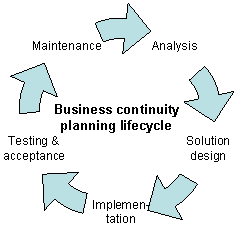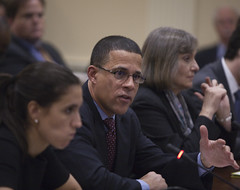Five steps you can take to make sure your company survives catastrophe.
CFO Magazine |
| NASA Satellite Image of Japan Captured March 11, 2011 (Photo credit: NASA Goddard Photo and Video) |
March 1, 2012
Yasmin Ghahremani -
Say this much for disasters: they're educational. Some, like Y2K, may offer useful lessons in overreaction. Others, like 9/11, may remain largely incomprehensible. But most, from Hurricane Andrew to the crisis surrounding Japan's Fukushima nuclear plant, have pushed companies to develop better response plans. …… Last July, reinsurer Munich Re said that 2011 had already become the most costly year on record for economic losses, due to the number of severe natural catastrophes in the first six months.
The lessons learned in the aftermath of so much tumult — along with technological changes and the increasingly interdependent nature of global business — have forced a rapid evolution in business-continuity planning. … "The marker was 9/11," says Roberta Witty, a research vice president for technology consultancy Gartner. "Until then I think most people were looking at IT disaster recovery and had never experienced an outage where the workforce itself would be so severely impacted."
 |
| Image via Wikipedia |
1. The Really Big Picture
…Today's leading companies are integrating people, processes, data, and physical infrastructure into a holistic approach to business continuity (sometimes referred to as business resilience).

 |
| Citigroup (Photo credit: LoopZilla) |
He's had plenty of chances to test that conclusion, one of the most dramatic coming after the Haiti earthquake in 2010. …
Workers who weren't buried in the rubble struggled to make sense of what was going on. One of them was able to contact Citi's regional crisis-management team in Mexico before telecommunications went down. Immediately, the Citi crisis-management team activated its command structure, coordinating the company's response. Citi security helicoptered in security personnel to help rescue employees and transport the injured to the Dominican Republic. Within a week the team was delivering humanitarian supplies to the area, eventually providing 15 tons of aid, including satellite phones.
Tragically, 5 of Citi's 43 Haiti employees were killed in the earthquake. But the company's response was deemed critical in providing care for other workers and getting the business back up and running quickly.
… "From a people, humanitarian, and business perspective, everything and anything that was asked for was coordinated through our central team," says Odermatt. "I think that's the secret to any successful recovery."
Of course, military-style logistics like that don't happen on the fly. Citi's arrangements were well established and practiced before the Haiti earthquake. …
Throughout the world, every line of business at Citi is involved in continuity planning. Rigorous testing and crisis planning involve everyone from the CEO down and occur at every level of the organization. "In addition, there is joint industry testing where the markets make themselves available so we can test our technology on nonproduction days," says Odermatt. "I think such testing is one of the things that set the financial industry above other industries."
 |
| Image via Wikipedia |
A decade on, one legacy of the 9/11 attacks has been to highlight the interdependence of the public and private sectors. "Governments realize that a large portion of public services is provided by private enterprise, so government is very dependent on business," says Gartner's Witty. "And private enterprise is starting to recognize that without first responders — the police, road crews, and government — you can't do anything."
 |
| Public Private Partnership Legislation Testimony (Photo credit: MDGovpics) |
At the local level, liaisons in all 10 of FEMA's regions are developing relationships with community businesses to facilitate resource and information exchange. In an emergency, FEMA and local emergency officials [determine] the status of utilities, communications, medical facilities, and food and supplies, ... They can then feed that information back to local businesses, …. In turn, businesses may have resources to share, such as disaster hygiene kits or parking lots that can be used for emergency operation centers.
 |
| Verizon Wireless Amphitheatre at Encore Park credit Chris Lee when using for gtg (Photo credit: Alpharetta CVB) |
… More than 45 Verizon Wireless crisis-management teams are dispersed across the country to respond to local needs, while a central team and hotline coordinate requests for emergency wireless voice and data products or wireless network support.
Requests may come from, say, the American Red Cross for 20 loaner mobile phones, or from officials in remote locations needing what Verizon Wireless refers to as a "cell on wheels." "We have these mobile assets that we can deploy to help agencies set up mobile command centers without which they really could not operate as effectively," says Gabe Esposito, Verizon Wireless's director of corporate security, business continuity, and disaster recovery.
3. Shoring Up Supply Chains
Hurricane Katrina in 2005, the 2010–2011 floods in Australia, and particularly the earthquake and tsunami in Japan last year have all emphasized the vulnerability of international supply chains. "While companies were able to recover their operations [following the disasters], they may not have been able to get the components they needed to restore manufacturing," says Greg Bell, a partner at KPMG. "People have been thinking about everything from, 'Do I need more supplier diversity for my key parts?' to, 'How do I get visibility into my suppliers' business-continuity plans?'"
 |
| Goodyear Blimp (Photo credit: ReneS) |
… The company estimates that 15% of all the crises it deals with are related to product-supply disruptions. With that in mind, business-continuity managers joined with the purchasing department to … [pinpoint] about two dozen raw-material suppliers in the first round, and the continuity team is now working with them to beef up resiliency planning.
… Outsourced services from managed data centers or technology providers raise concerns. … "Many companies, including Citi, outsource their services and do enormous amounts of offshoring," says Citi's Odermatt. "There's more-intense focus now on what those suppliers' supply chains are, what their business-continuity plans are, and whether they're being tested."
4. Virtually Bulletproof
In the data center, virtualization has been lauded as a boon for business-continuity planning. In this technology, multiple virtual machines … can run independently on one server. … While regular servers normally run at only 5% to 15% capacity, a server running virtual machines can operate at 60% to 80% capacity.
Because virtual machines are independent of the hardware they run on, they can be easily moved around a firm's network or to any other server deemed necessary. Copies can be saved offsite for disaster-recovery purposes.
The Texas Association of School Boards had those benefits in mind when it rebuilt its data center three years ago using virtual machines. … When it began the virtualization process, only 8 of its 100 applications could be recovered from a mirror site after a disaster. Now, 94 can be brought back up within 15 minutes.
For system administrator Toni Fowlie, however, the project generated new problems. When wildfires swept the central Texas area last summer, her concerns about the heat outside were minor compared with what was going on in the data center. "I didn't worry so much about the fires, but I do worry about power," says Fowlie.
The reason is the blade servers that run the Texas agency's virtual machines. …"Power-to-performance is greater, but you're performing more and you're condensing more," says Mark Vanston, director of business continuity and recovery services for HP Enterprise Services. …
Cloud computing, while still in its infancy, could alleviate some of these headaches, but will likely also raise new ones for disaster-recovery managers. Not only will they need to worry about the viability of their cloud suppliers, they will also have to create contingency plans regarding Internet connectivity to those suppliers.
5. All Together Now
For crisis communications, a new, democratic order is at hand. … "Social media is not just a new way to broadcast information," says John Orlando, a social-media consultant. "It reverses the direction of communications."
Researchers from the universities of Colorado and California at Irvine found that during the Southern California fires of October 2007, residents turned away from mass media and official sources of information and looked to peer-to-peer resources such as blogs, community forums, e-mails, text messages, and Twitter to find out whether a fire was headed down their street. These outlets provided better, more-timely information, as well as the means to disseminate it. In many instances, the participation of community members helped keep rumors in check and validate information from reliable sources. …
"Emergency managers have to understand that the public is going to self-manage the disaster with or without them," says Orlando. "So the challenge is to develop a collaborative model where the old assumption that the public is a problem to be managed is replaced with the assumption that the public or your employees are a resource to be harnessed."
The private sector has been slower on the uptake, but it is beginning to use social media to converse with customers during emergencies. TD Bank used its existing Twitter program to monitor consumers' concerns during Hurricane Irene. When questions about available ATMs and branch closings cropped up, the 10-person Twitter team responded with updates and links to mobile apps showing available facilities.
Still, corporate social-media programs to communicate with employees during emergencies are but a future vision for most companies. Orlando suggests that corporate Facebook pages could be used by employees of companies that have been shut down by a crisis. "Instead of just communicating information outward, it can be a way for people to coordinate their needs with one another," he explains. "They can ask, 'Can someone pick up my daughter from school?' or, 'Could someone pick up groceries for me?' And by [providing] a place where they can form a community and call on one another, you'll make it much more likely that they'll be there for you when it's time to start up business again."
Yasmin Ghahremani writes about business and technology from Austin, Texas.










No comments:
Post a Comment